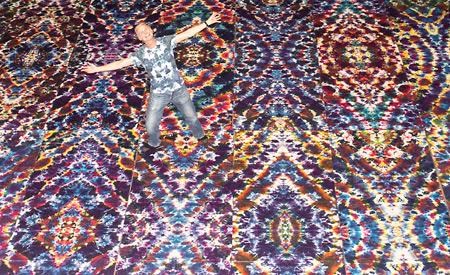VIDEO – Thirty years ago, Courtenay Pollock, a renowned tie-dye artist who has lived in Powell River since 2004, created a stunning backdrop for a Grateful Dead concert at the Greek Theatre in Berkeley, California. This weekend, his work will provide the backdrop for three concerts at the same venue by a band that contains two original Grateful Dead musicians.
The concerts, on September 27, 28 and 29, give Pollock, who became famous for the speaker fronts, backdrops, T-shirts and mandalas he created for the Grateful Dead, an opportunity to showcase his work again on the big stage.
Although the Grateful Dead officially disbanded four months after Jerry Garcia, lead guitarist, singer and songwriter, died in August 1995, band members continued to perform, sometimes reuniting in new groups. In 2009, two founding members of the Grateful Dead, Bob Weir and Phil Lesh, founded Furthur, named after the famous multicoloured bus used by Ken Kesey and the Merry Pranksters in the 1960s.
In 2010, Furthur commissioned Pollock for a backdrop that went on its North American tour. Fifteen nine-foot by nine-foot panels combined to create a 45-foot long by 27-foot high mandala backdrop.
Further next commissioned Pollock to create a backdrop for its Greek Theatre concerts. The newest backdrop, 24-feet high and close to 60-feet wide, fits the back wall of the theatre. That meant 32 panels had to be designed to fit into the overall concept Pollock had in mind.
Furthur will be playing the same music that was played 30 years ago, Pollock said. John Kadlecik, of the Grateful Dead knockoff band Darkstar Orchestra, takes Garcia’s spot in concert. “He’s a wonderful player,” said Pollock. “He developed his style to sound like Jerry Garcia because, after all, they’re trying to reproduce the Grateful Dead sound.”
Although he doesn’t look like Garcia, he does sound like him, in both his guitar playing and his vocals, said Pollock.
Pollock had an idea for the overall design of the backdrop in mind, but the execution came panel by panel. “Until the panels are laid down and put together, it’s hard to know what it’s going to come out like,” he said.
It took Pollock a month to dye the panels. Through the summer, he was experimenting with different ideas on other fabrics using large 10-foot-by-10-foot areas, which is what he usually uses for backdrops. “Nothing was working for me,” he said. “I wasn’t satisfied with the results. The colours weren’t brilliant enough, because of the coarseness of the cloth or the heaviness of the cloth.”
The heaviness of the material is a determining factor in how much finite detail he can achieve, Pollock explained. “When it’s too heavy, you can’t get the penetration through layers of cloth. You need a lightweight, high-density weave cloth.”
Pollock finally decided on a quilter’s cotton sateen for the panels, which has polished cotton on one side. “It’s beautiful, like high-quality shirting material,” he said.
Pollock uses Procion dyes, which are used in cold water and are not toxic. “The dyes I used in the early days were hot water dyes and they were very toxic. But I loved the brilliance and dynamics of using them and you could get better penetration using hot water dyes.”
Over the years, he found a way to make the Procion dyes work for him. “For years, I couldn’t work with these dyes. I just couldn’t get the brilliance. But I found out you just have to put a lot more of everything in to make them work for my method.”
Pollock has created the word “geometriart” to describe his method, which he also calls “fabric fractal art.” He uses a geometric folding technique to create perfect symmetry in all of his designs. He developed the method, which is similar to origami, during the psychedelic era of the 1960s, when he first started to tie-dye.
Each of the 32 panels for the Greek Theatre backdrop is 45-inches wide by 12-feet high. With the help of two of his friends, Pollock used the Arbutus Room floor in Powell River Recreation Complex to lay out the panels just over a week ago.
At first he wasn’t happy with how the backdrop looked. He worked for a few hours moving the panels around to achieve a better continuity, searching for the ultimate combination of flow, balance and dynamics. In the end, he was pleased with his creation.
Pollock labelled the panels in preparation for taking them to a firm in Vancouver where they will be sewn together, a process that he oversees to ensure they go in the right positions.
Pollock is not sure what will happen to the backdrop after the concerts. A private collector purchased the last one he created and it is being used in a California winery. Perhaps a private buyer will want to purchase the new one, Pollock said. “Ideally, I would like to see it hang somewhere,” he said. “An arts museum. The Smithsonian would be great. Rock and Roll Hall of Fame. It would qualify for a place there, because of the impact of my work with the Grateful Dead and the influence it’s had on generations of rock and roll-goers.”
More of Pollock’s work is featured in the cover art of Sunshine Daydream, a film of a benefit concert the Grateful Dead did for the Kesey family’s Springfield Creamery in 1972. The band travelled to Veneta, Oregon where a stage was erected at the Olde Renaissance Fairgrounds for the event. Sunshine Daydream, first shot on 16-millimetre film, has been restored to high-definition resolution, while the audio was remastered as well. It was shown in select theatres in August. In September, the film was made available on a disc, presented in an original tie-dye slipcase by Pollock. His art also adorns the CD cover, as well as a vinyl record released along with the film.
Interested readers can find more information about Pollock on his website.



